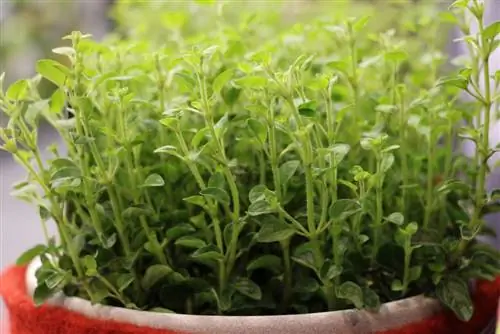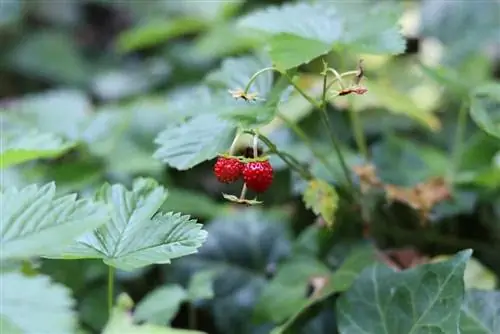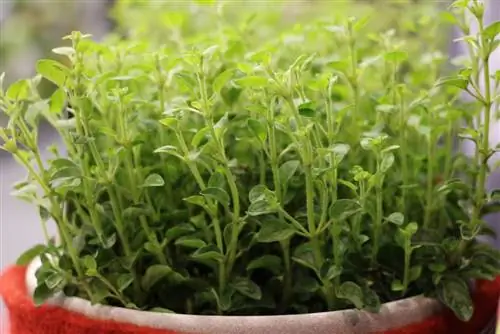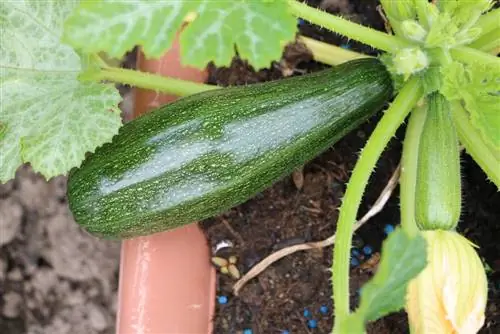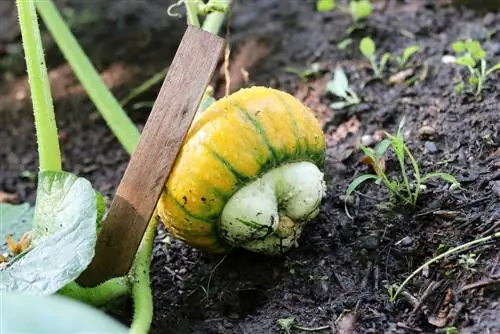- Author admin [email protected].
- Public 2023-12-17 03:39.
- Last modified 2025-01-24 12:45.
Oregano (Origanum vulgare) or also known as wild marjoram and dost, is the Italian national spice and brings Mediterranean flair to many dishes. When the decorative plant with its spicy character spreads, it presents itself in a dense bush that scores with countless pink and purple flowers during the flowering period from July to August.
Caring for the fragrant garden perennial is easy if the optimal requirements for location, soil conditions, watering and correct overwintering are observed.
Known subspecies
Oregano grows in all temperate and warm latitudes. However, there are various subspecies that are not only found in Italy. The best known species are:
Mexican Oregano
- Botanical name: Poliomintha longiflora
- floriferous shrub
- native to Mexico and Texas
- intense aroma with pepper note
- can be cultivated as a container plant
Greek Oregano
- Botanical name: Origanum vulgare subsp. hirtum
- native to Provence in southern France and Italy
- Spice, nectar and fragrant plant
- sunny location, calcareous soil
- hardy
Italian Oregano
- Botanical name: Origanum x majoranicum
- is grown in Asia and Europe
- Scent dispenser, herb and green structural plant
- cultivate in a pot in sunny, warm locations
- prefers loamy, sandy and calcareous soil
Location / Soil
Due to its origins in southern climes, oregano loves warmth and is hungry for sunshine. The location should be chosen accordingly. A spot in partial shade is also possible. When it comes to soil, the Mediterranean plant is content with normal garden soil. A dry, calcareous and air-permeable soil has a positive effect on the growth and he alth of the herb plant. If the substrate is loose, the roots are optimally supplied with oxygen and excess water drains away easily.
To aerate the soil, simply mix in gravel or sand. The substrate can be loosened additionally with coconut fibers. Together with other herbs such as lavender, rosemary or thyme, Origanum vulgare looks good in the common bed. However, there are also vegetables that have similar care requirements as the popular herb. Suitable plant neighbors include.
- Onions
- Carrots
- Tomatoes
- Leek
- Pumpkin
Tip:
If the cultures are mixed, oregano promotes the development, aroma and he alth of the vegetables.
Watering / Fertilizing
Watering also shows how easy oregano is to care for. However, it reacts sensitively to too much moisture and the southern spice bush does not like waterlogging. Before watering, make sure that the top layer of soil is dry. The finger test helps here. Because oregano in its homeland sometimes has to endure prolonged periods of drought and intense heat in the summer months, it sometimes survives breaks in watering in our latitudes. Use rainwater for watering as it is richer in nutrients than tap water. Bales must never be kept permanently wet. Potted plants are usually watered once a week. The rule of thumb is: the more leaves, the more frequently you water.

Fertilizer is used sparingly with Origanum vulgare. Fertilizer application in the herb bed is limited to once a year. Fertilization is carried out in spring with conventional herbal fertilizer, vegetable fertilizer or compost. Potted plants are additionally supplied with nutrients between July and August.
Cutting and Harvesting
The growth of oregano can sometimes get quite out of hand. So that potential plant neighbors are not disturbed, it is important to cut the southern herb regularly. To do this, it is cut back to a hand's width above the ground. Pruning stimulates growth. Within a short time the perennial sprouts again. Even during the growth phase, you can simply cut the plant back at any time. The aromatic content of oregano is at its highest when it blooms. This is the best time to harvest it. For this purpose, the plant is cut off above the branching point. The complete harvest is recommended after flowering.
Wintering
Oregano is adaptable and a true survivor. It can also cope with extreme cold in the cold months, as it is often exposed to cold winters in its homeland. However, the winter and frost hardiness depends on the respective variety. The herb also needs a certain adjustment period to get used to extreme winter cold. This makes it necessary to install winter protection as early as the first night frosts. Brushwood, fleece and mulch, which are piled up around the plant, can be used to protect the plant and the soil. Things are a little different with potted plants. Since the substrate does not offer sufficient winter protection, it helps to wrap straw mats or garden fleece around the bucket. An appropriate base under the pot and a place protected from the wind provide additional protection. If the oregano is cultivated on the windowsill, it can be left standing or moved to a cooler room.
Tip:
Do not fertilize in winter, but keep moist and water on frost-free days.
Propagate
The Mediterranean plant can be easily propagated by division. To do this, the mother plant is separated in spring or autumn. In addition, oregano can be propagated by seeds and cuttings.
Cuttings
- Provide a bowl or cup with a hole in the bottom
- Remove leaves from the long cut stem
- Leave the crown on the stem
- Place the stem on a support and cut off from above under the third eye (place where the leaf was sitting)
- Fill the bowl or cup with coconut fiber soil, insert the cuttings and water
- Do not repot the cutting until roots protrude from the container
Sowing
- Light germinator
- Sprinkle seeds on suitable soil and do not cover
- keep moist
- Germination time eight to 14 days
- Pre-breeding on windowsill possible from February
- Sowing outdoors only after the Ice Saints
Diseases and pests
Oregano is quite robust and not very susceptible to pests or diseases. However, incorrect location and care errors can lead to the leaves wilting and dying. Sometimes it can happen that the Origanum vulgare is attacked by cicadas and aphids.
Cicadas
- insects sucking on leaves
- lay their eggs on the leaves
- can infect the plant with fungal spores
- Insert yellow boards or
- spray affected leaves, especially the underside
- for spraying, dilute a solution of neem oil or vinegar essence with water
Aphids
- Flowers and leaves are affected
- remove by scraping or rinsing
- wash affected areas with a sponge and detergent solution
- provide natural help ladybugs
Frequently asked questions
What to do about wilted oregano leaves?
Wilting leaves can sometimes be due to the plant being left in damp or wet soil for too long. It is advisable to allow the soil to dry out and take a break from watering. As a preventative measure, only water when the substrate has dried thoroughly. A complete substrate change is also recommended.
How do brown spots on the lower leaves explain?
On the one hand it can be due to high temperatures in summer and on the other hand watering in the midday sun can cause burns on the leaves. Here it is advisable to cut off all brown leaves. The plant sprouts again quickly.
What you should know about oregano in brief
Profile
- Height: 15-50 cm
- Flowering time: July to August
- Location: sun-partial shade, dry and nutritious soil
Usage
Origanum can be used in many dishes: salads, soups, sauces, meat, poultry, pizzas, pasta, egg dishes, vegetables, legumes, side dishes. When prepared as a tea, it has an appetizing, draining and expectorant effect.
Wintering
When overwintering, oregano, which is so hungry for heat in summer, is quite tough; it is also familiar with winter cold from its homeland. If a plant like oregano, which doesn't give up at the slightest hint of cold, has survived in our garden for a few years, it will even be able to withstand quite a bit of cold; you hear of dost plants that grow down to -20 °C have survived. It certainly can't hurt if you protect the oregano and garden soil with a layer of mulch.
Harvesting and cutting
- With oregano, the harvest only begins when it flowers, then it has the highest aroma content.
- If you need oregano beforehand, you can of course cut off individual portions - ideally above a branch.
- The complete harvest directly after flowering will then contain many small and highly aromatic leaves.
- This pruning then extends to just a hand's width above the ground, so you can definitely cut off entire branches including the flowers.
Preserving Oregano
Oregano is suitable for freezing, best in ice cube trays filled with a little water so you can take out individual portions. To dry, you can tie the entire branches together. The small bouquets should be allowed to dry slowly in an airy and dark room; the flowers can be used for seasoning.

